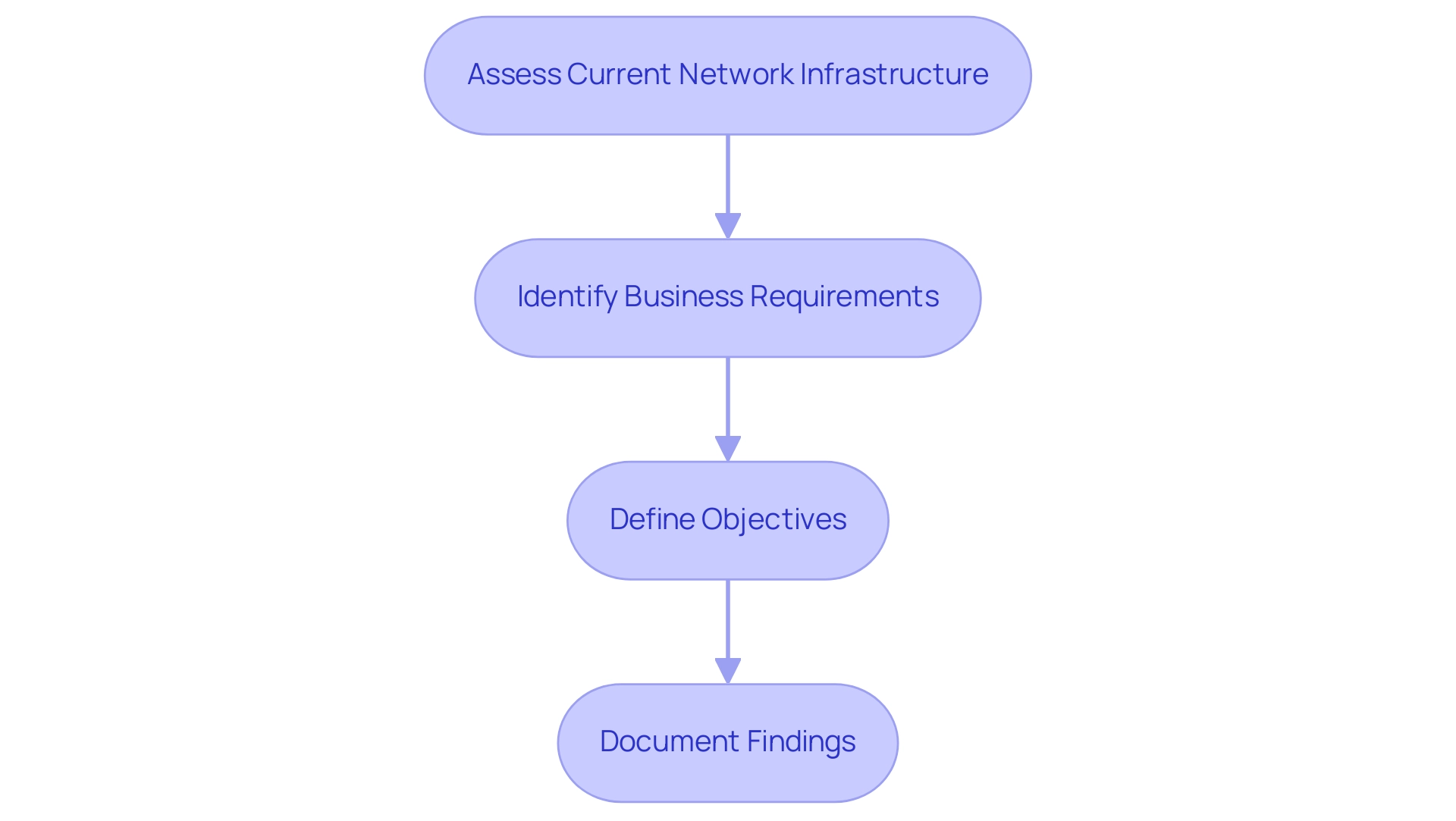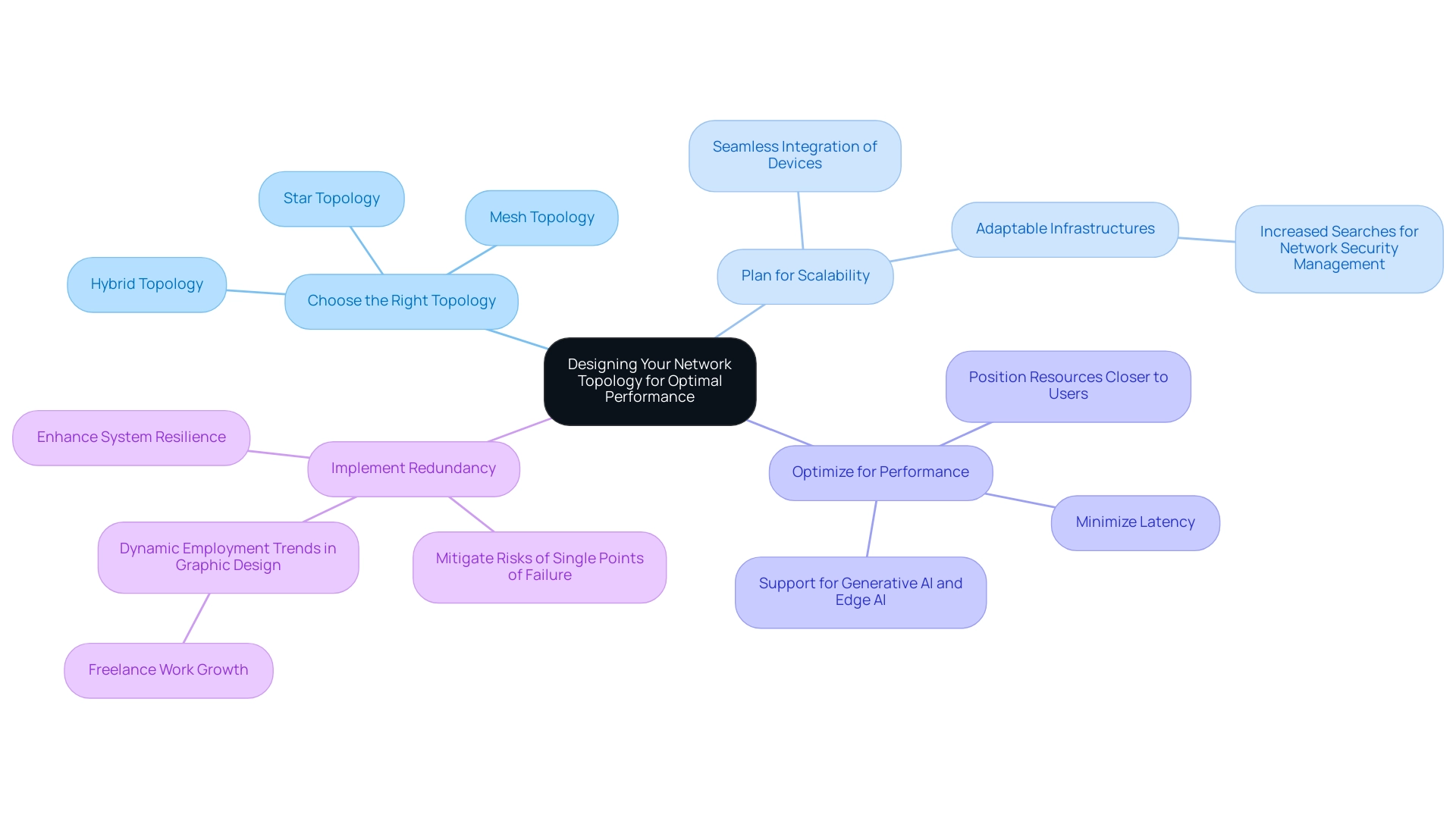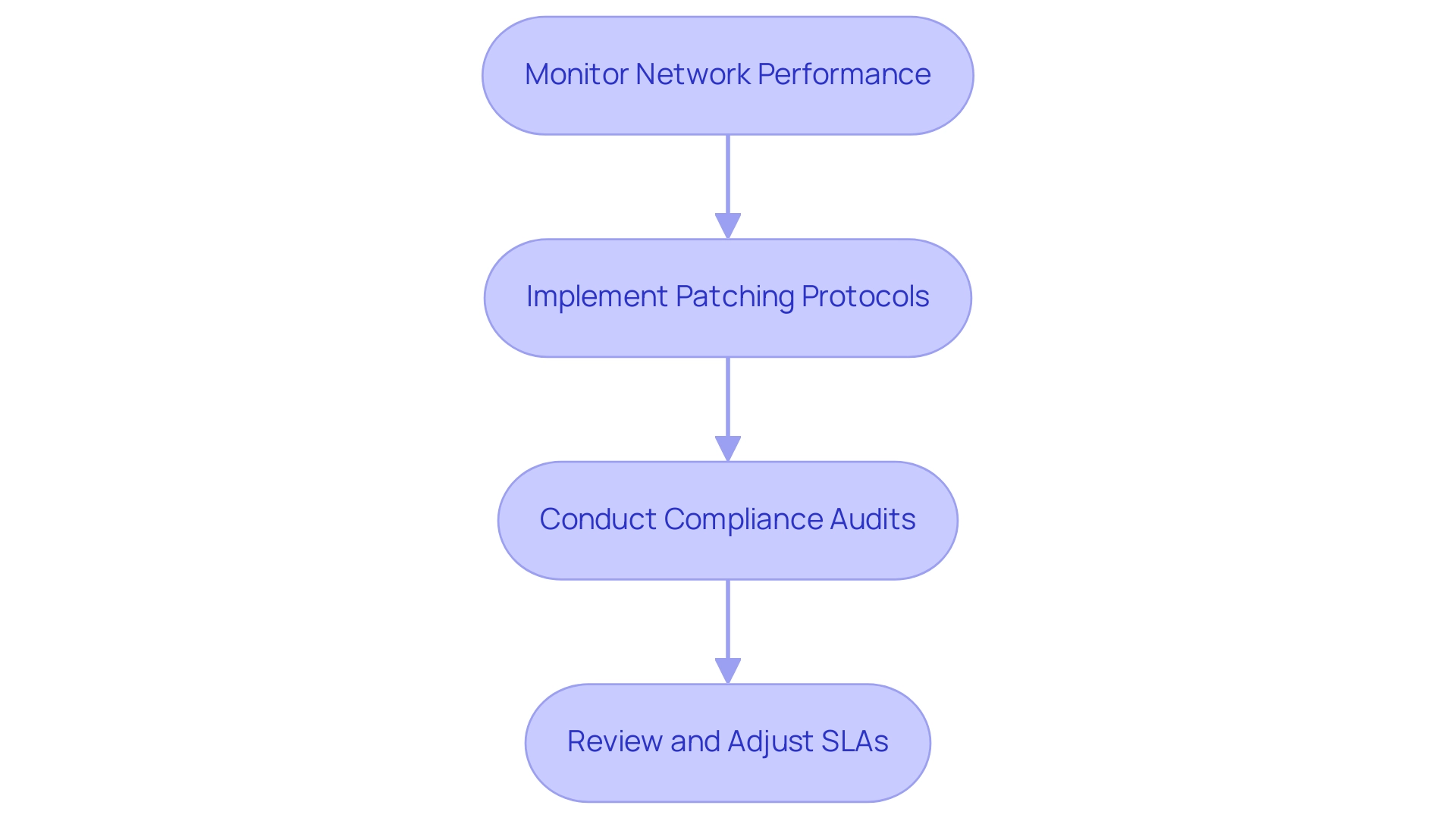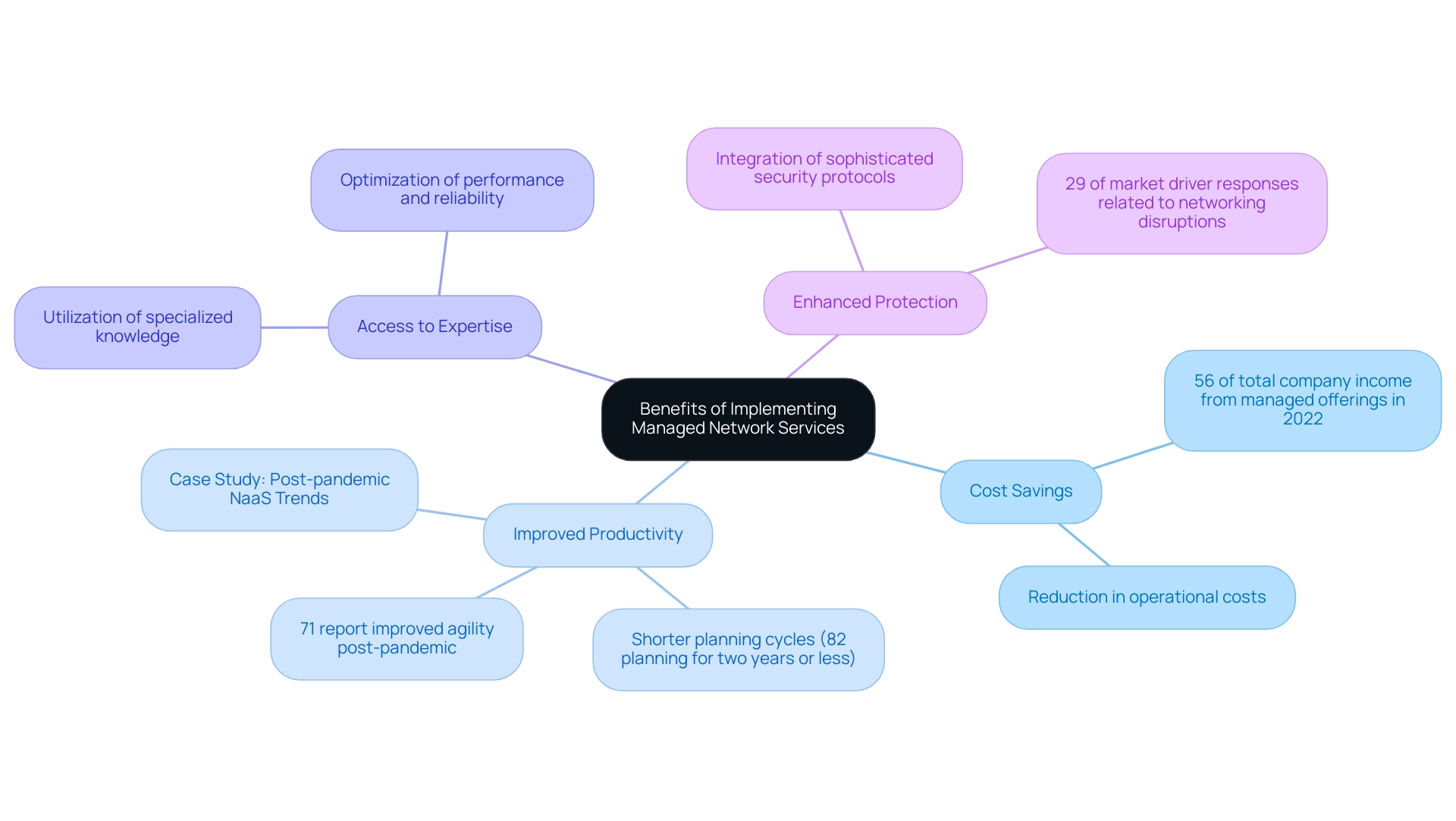Introduction
In the rapidly evolving landscape of technology, effective network management has emerged as a cornerstone for organizational success. This discipline encompasses a range of processes and technologies aimed at overseeing network resources and services, ensuring optimal performance, reliability, and security.
As enterprises increasingly rely on advanced network management solutions, understanding key concepts such as:
- Network topology
- Protocols
- Service level agreements
becomes essential. The growing trend towards Network as a Service (NaaS) and the shift towards edge computing highlight the pressing need for organizations to adapt and innovate.
However, the path to effective network management is not without its challenges, as financial constraints can hinder progress. This article explores the fundamental principles of network management, offering insights into best practices, ongoing maintenance tasks, and the strategic advantages of implementing managed network services, thereby equipping leaders with the knowledge necessary to enhance operational efficiency and customer satisfaction in a connected world.
Understanding Network Management: Key Concepts and Importance
Oversight of resources and functions is a vital field that includes managing network services and the processes and technologies required for supervising connectivity assets. This involves continuous monitoring of system performance, ensuring reliability, and maintaining robust security measures. Grasping basic principles like topology, protocols, and service level agreements (SLAs) is crucial for effective administration.
Current trends suggest an increasing dependence on sophisticated system oversight technologies, with substantial effects on operational efficiency and customer satisfaction. Nonetheless, challenges continue; for example, 31% of Chief Information Security Officers (CISOs) indicate that projects have been postponed or eliminated due to insufficient funding, emphasizing a significant obstacle to efficient system oversight. Moreover, as platforms such as YouTube illustrate, where users engage for an average of 48.7 minutes daily, the significance of strong system management becomes clear in facilitating high-traffic applications.
Rebecca Grassing, a Product Marketing Manager at Auvik, emphasizes this shift, noting that more companies will look toward edge computing to optimize processing power by moving it closer to the outer nodes, which have untapped processing potential for cloud systems. This shift is further reflected in the adoption rates of offerings like Amazon Web Services (AWS), which rose from 67% in 2019 to 80% by 2022, showcasing a strong market presence and the increasing reliance on Network as a Service (NaaS) solutions among enterprises. Thus, mastering these essential concepts and staying updated on the latest advancements in management is vital for any leader seeking to improve operational efficiency and provide reliable support, thereby increasing overall customer satisfaction.

Essential Steps to Begin Managing Network Services
To manage services effectively, it is crucial to follow these essential steps:
- Assess Current Network Infrastructure: Begin by conducting a thorough evaluation of your existing network setup. This includes cataloging devices, reviewing configurations, and analyzing performance metrics to identify any bottlenecks or vulnerabilities within the system. Recent statistics indicate that entities prioritizing infrastructure assessment in 2024 will significantly enhance their operational efficiency. Furthermore, Q4 2023 performance statistics suggested potential recovery for listed infrastructure, with the FTSE Global Core Infrastructure 50/50 index attaining an 11.1% quarterly return, emphasizing the significance of strong infrastructure oversight.
- Identify Business Requirements: Next, ascertain the particular needs of your entity that will direct your system oversight strategy. This encompasses understanding bandwidth requirements, security protocols, and compliance standards that are critical to your operational framework. As the landscape evolves, with projections indicating that by 2026, 30% of Network as a Service (NaaS) solutions will integrate 5G capabilities, your organization must be prepared to adapt to ultra-fast connectivity speeds for supporting real-time data processing.
- Define Objectives: Establish clear, measurable goals for your system oversight strategy. These goals may include improving uptime, enhancing security measures, or optimizing resource allocation. Engaging with IT experts about their insights on defining these objectives can further refine your approach. As Tajammul Pangarkar, CMO at Prudour Pvt Ltd, suggests, understanding the dynamics of system management is essential for navigating the tech landscape effectively.
- Document Findings: Create a comprehensive document that outlines both your current system state and identified requirements. This document will act as an essential reference for overseeing future activities, ensuring that all stakeholders are aligned with the entity's goals. Furthermore, consider the challenges faced by the power and utilities sector, which experienced record rate case requests and increased spending on infrastructure in 2023. This sector is getting ready for a possible tripling of electricity demand by 2050 in the context of rising inflation and interest rates, highlighting the necessity for efficient system oversight strategies to meet infrastructure requirements. By diligently following these steps, you will lay a robust foundation for effective services management, enabling your organization to navigate the complexities of modern connectivity with confidence.

Designing Your Network Topology for Optimal Performance
In the domain of topology design, several fundamental principles are essential for optimizing performance and ensuring scalability.
- Choose the Right Topology: Selecting the appropriate topology—whether star, mesh, or hybrid—should align with your specific business needs.
Each topology presents distinct advantages, catering to different operational requirements. For example, a star topology may be favored for its simplicity and ease of troubleshooting, while a mesh topology offers enhanced redundancy and reliability, critical for mission-critical applications.
-
Plan for Scalability: Future growth must be a cornerstone of your system design. A scalable network architecture allows for the seamless integration of additional devices, ensuring that expansion does not hinder performance. Notably, searches for 'network security management' were roughly three times higher in December 2023 than a decade before, reflecting a growing recognition of the need for adaptable infrastructures that can evolve with technological advancements.
-
Optimize for Performance: Positioning critical resources closer to end-users is vital for minimizing latency and improving access times. This optimization not only enhances user experience but also supports the increasing expectations for instantaneous connectivity, especially as organizations adopt generative AI and edge AI solutions in 2024.
As Matt Loy pointed out, in August 2023, Google experienced over 2.8 billion visits in Russia, emphasizing the critical need for effective infrastructure design to manage high traffic and user engagement.
- Implement Redundancy: Reliability is paramount in system design.
By incorporating redundancy, you mitigate the risks associated with single points of failure, thereby enhancing overall system resilience. This practice is crucial in today’s landscape, where operational continuity is non-negotiable. The dynamic employment trends in graphic design, with around 507,690 graphic designers engaged worldwide and many shifting towards freelance work, demonstrate the need for flexible design systems that can respond to changing demands.
By following these principles, entities can significantly enhance their connectivity performance and reliability, which is essential for managing network services and positioning themselves effectively within a rapidly evolving technological environment.

Ongoing Management Tasks for Network Services
To ensure the effective maintenance of network services, organizations should actively engage in the following ongoing management tasks:
-
Monitor Network Performance: Regularly reviewing performance metrics is crucial for identifying and resolving issues before they adversely affect users' experiences. According to the latest statistics, the top 7 monitoring software, based on over 3,000 reviews, highlights the importance of robust performance monitoring solutions. This proactive approach to managing network services helps to maintain optimal functionality and user satisfaction.
-
Implement Patching Protocols: It is essential to keep all devices updated with the latest security patches to safeguard against vulnerabilities. As management specialists highlight, "Robust patch management is critical for enhancing security, particularly given the increasing sophistication of cyber threats." This emphasizes the necessity of effective patching protocols in today’s digital environments.
-
Conduct Compliance Audits: Periodically auditing your network against established compliance standards ensures adherence to relevant regulations and internal policies. This not only mitigates legal risks but also reinforces trust with stakeholders.
-
Review and Adjust SLAs: Regular evaluations of level agreements (SLAs) are necessary to align them with current business needs and technological advancements. Adjusting SLAs to reflect changes in expectations can significantly enhance operational efficiency. Recent collaborations in the industry, such as the partnership between Gigamon and Riverbed to support unified visibility solutions, illustrate the evolving landscape of system oversight and the importance of keeping SLAs relevant.
By dedicating themselves to these continuous oversight activities involved in managing network services, companies can guarantee that their connectivity offerings stay strong, safe, and adaptable to changing requirements. This strategic focus is not just a best practice but a necessity in today’s fast-paced technological landscape.

Benefits of Implementing Managed Network Services
Implementing managed connectivity solutions offers organizations a variety of strategic benefits that are especially relevant in the present technological environment:
- Cost Savings: Outsourcing system oversight can significantly reduce the operational costs linked to maintaining an in-house team. As reported, managed offerings represented 56% of total company income in 2022, reflecting a growing trend towards cost-effective solutions, up from 44% in 2021.
- Improved Productivity: Managed solutions enable streamlined operations, allowing internal teams to focus on essential business goals instead of being hindered by management tasks. Organizations that adopt these models reported improved agility, with 71% indicating a shift towards shorter planning cycles post-pandemic. A case study titled 'Post-pandemic NaaS Trends' highlights this trend, showcasing how entities are rapidly adopting consumption-driven NaaS models to align expansion costs with digital experiences.
- Access to Expertise: Utilizing the specialized knowledge of managed providers ensures that systems are overseen by experienced professionals, thus optimizing performance and reliability. This expertise is crucial as entities navigate increasingly complex networking environments.
- Enhanced Protection: Numerous managed solutions integrate sophisticated security protocols, thus strengthening systems against emerging threats. This is especially crucial in a time when networking-related disruptions represent 29% of market driver responses.
By recognizing these advantages, entities are enabled to make informed choices about managing network services strategies, adhering to contemporary best practices and improving overall operational efficiency. As Sean Blanton, Director of Content at JumpCloud, aptly notes, 'The focus on managed services not only contributes to cost efficiency but also positions organizations to thrive in a competitive landscape.

Conclusion
Effective network management is increasingly recognized as a vital component of organizational success in today's technology-driven environment. By understanding key concepts such as network topology, protocols, and service level agreements, enterprises can navigate the complexities of modern connectivity. The strategic implementation of managed network services not only facilitates cost savings and enhanced operational efficiency but also ensures access to specialized expertise and improved security measures.
As organizations begin to adapt to trends such as Network as a Service (NaaS) and edge computing, the importance of a robust network management strategy becomes even more pronounced. The challenges posed by financial constraints and evolving technological landscapes necessitate a proactive approach, where ongoing management tasks play a crucial role in maintaining optimal network performance and reliability.
In conclusion, the path to effective network management is multifaceted, requiring continuous assessment, strategic planning, and a commitment to ongoing improvement. By embracing these principles, organizations can enhance their operational capabilities, meet customer expectations, and position themselves for sustained success in an increasingly connected world. The future of network management lies in the hands of those who are willing to innovate and adapt, ensuring that their networks remain resilient and responsive to emerging demands.




